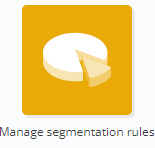Segmentations
Segmentations are an important component of your profile table. They indeed let you record the affiliation of a profile to a group of profiles on the basis of a common characteristic.
These groups are a preferred tool to let you send the right message to the right person (for example, via a segmentation according to the consumer type: Gold, Silver or Bronze) and at the right time (for example via a segmentation based on purchase frequency).
There are two kinds of segmentations:
-
Exclusive segmentation: it allows you to group profiles sharing common characteristics in a segmentation containing several segments. The affiliation of a profile to one of these segments is characterized by its tier, by reaching a threshold.
Example: RFM segmentation: Gold, Silver and Bronze. Online activity segmentation: Very active, Active, At risk, Inactive. Prospect, Client and Former client segmentation.
-
Simple segmentation: it allows you to groups profiles sharing common characteristics in a segmentation containing a single segment. The affiliation of a profile is characterized by true or false: either he is a member, either he is not.
Example: 'field of interest' segmentation: Sport, 'meat eater' segmentation, 'discount lover' segmentation.
Creating a segmentation is done via the 'Manage Segmentations' application (Catalog > Profiles > Manage Segmentations) .

This application is where you will be able to:
Create a segmentation
Segment profiles in a one-off way
Delete segmentations
Edit the name of a segmentation
View the distribution of your segments
Setting up automated segmentation rules is done via the 'Manage segmentation rules' application (Catalog > Automation > Manage segmentation rules) .

This application is where you will be able to:
Create a segmentation rule
View the definition of existing rules
Copy a rule
Stop a rule
Delete a rule
